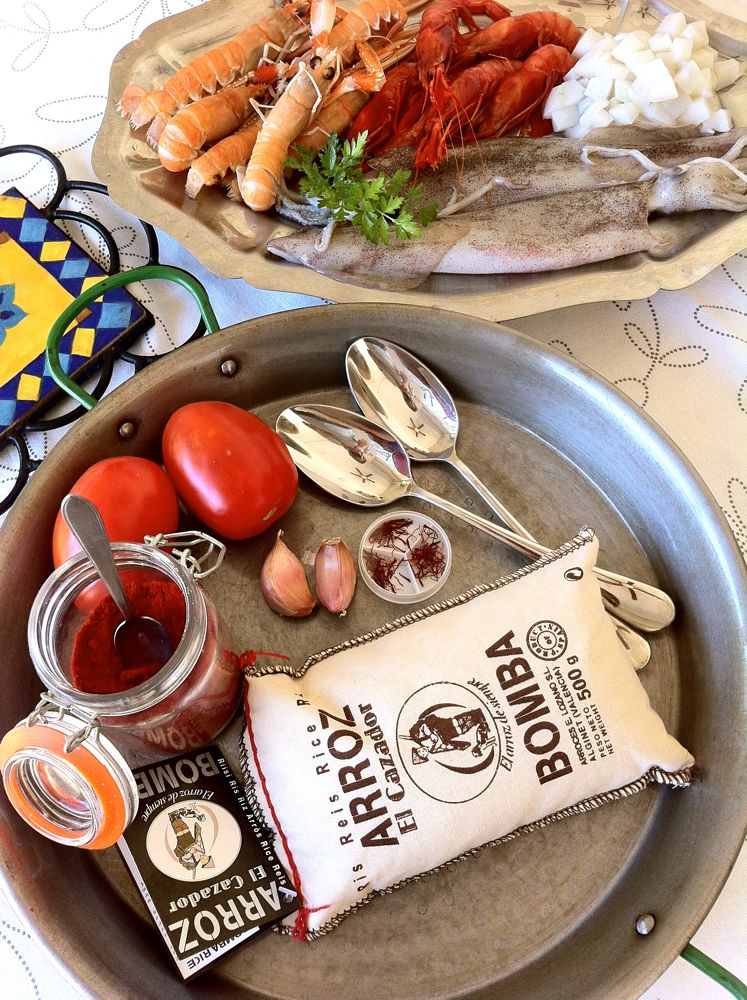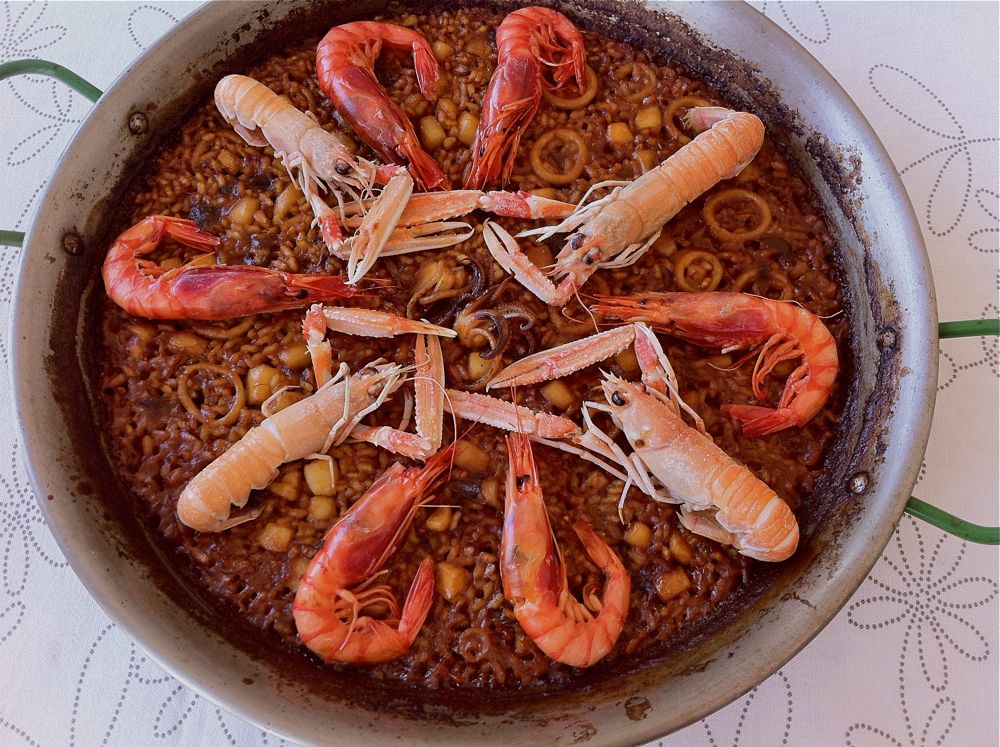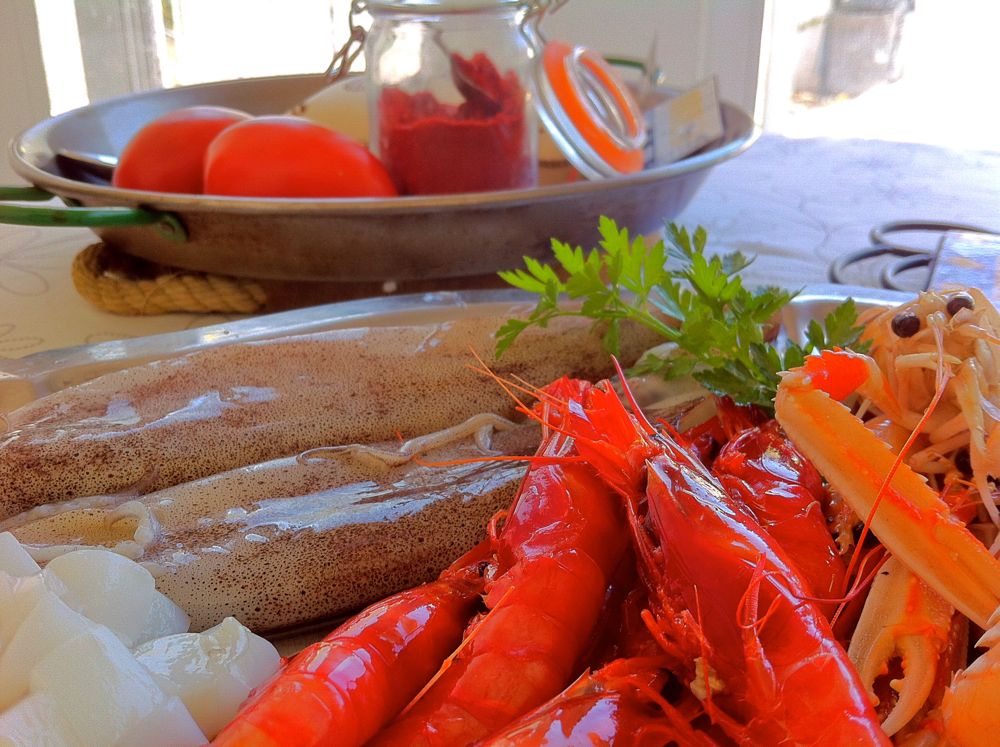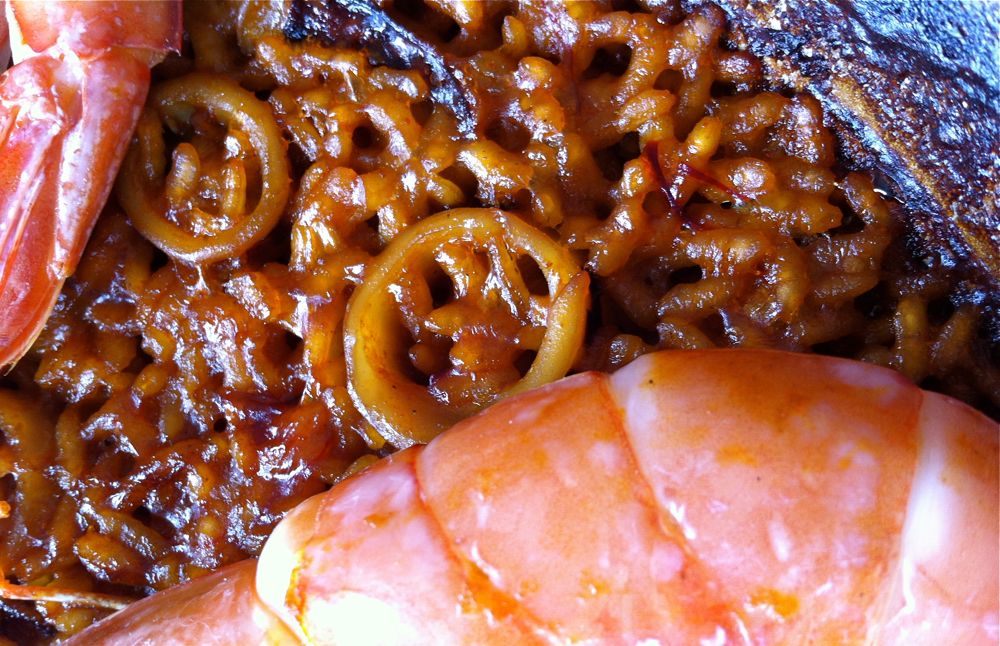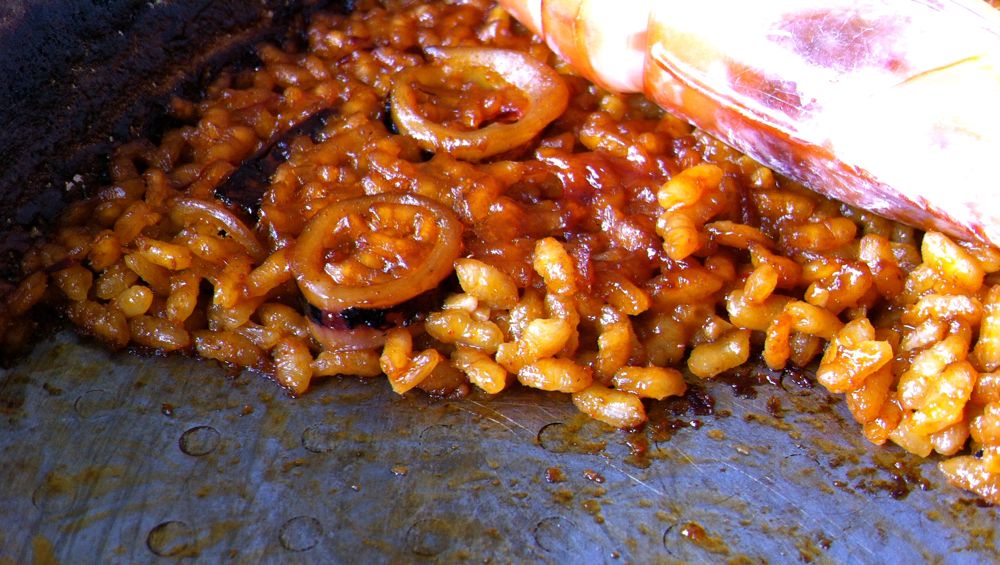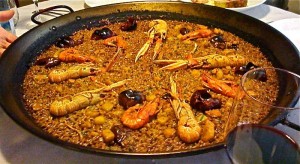Wednesday, May 22, 2013
Paella de Marisco (Seafood paella)
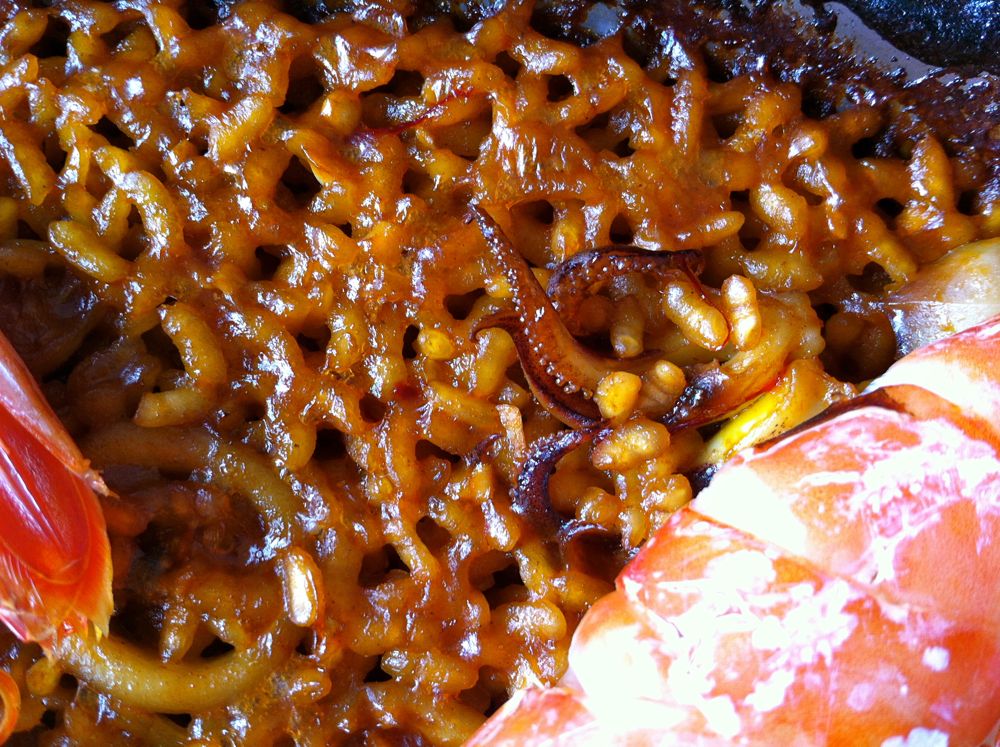
Ingredients
3 tablespoons of e.V. olive oil
1 clove garlic
1 ripe tomato, grated
1 tablespoon of tomato sauce
500 gr. broth
140 gr. rice bomba
1 pinch of saffron
1 teaspoon sweet paprika (pimienton dulce)
150 gr. cleaned squid
150 gr. cuttlefish clean
6 prawns
4 scampi
salt
broth
4 tablespoons of olive oil e.V.
2 handfuls of small shrimp or a combination of crabs, shrimp heads and shells, prawns etc..
2 generous handfuls of small fish for broth or fish white bones
1 onion
1/2 leek
2 carrots
2 cloves of garlic
1 or 2 ripe tomatoes or a few peeled
1 small glass of white wine
1 bay leaf
2.5 liters of water
Introduction
The dish is named after the typical pot "paella" where the main ingredient is cooked,the rice
The paella is almost flat, slightly concave. The idea is to cook the rice with its protein / vegetable on a flat surface, allowing all the broth to evaporate until dry. In fact, it is also called "arroz seco" - dry rice.
The basis for any good rice dish, is a good stock. If there is no stock, there is no rice!. Except that as a garnish (long grain basmati type).
Today I used squid, cuttlefish and shrimp, but you can also add other cut of fish, mussels and clams. I avoid clams because they dry easily in the paella. However, as I said before the important thing is a good broth and with that even if you do not have other substantial elements to add, you will get a good paella.
To cook the paella there are three ways: a wood fire, on the appropriate gas burner for paella or on the burner ( even normal if not for a very large paella ) and then in the oven. This last one is what we do because we will not need the special paella ‘s gas burner and by finishing it in the oven, it will dry even better, with a perfect result!. It is absolutely not easy to get the cooking right in the other two modes. It ‘s matter of handy experience, and the balance between fire and liquid. But if you follow carefully my steps, I’m sure that you will get a good paella at first!. If you do not have a paella, use a flat pan. Of course with metal handles for the oven.
So let’s focus on a good stock, not a classic fumet (delicate and light), but a strong broth with crustaceans and also small rock fishes or fish bones. We begin by frying the onion, carrots, and leeks (chopped coarsely) and two cloves of garlic with 4 tablespoons of olive oil. When browned add the crustaceans (shrimp, crabs, shrimp heads and shells etc..), Roast it for a few minutes without rushing. Add a couple of plum tomato and when just reduced add the white wine. Then add the water, a bay leaf and as it begins to boil, cook over medium heat for half an hour, then add the rest of the fish or bones. Another half hour and turn off. Let infuse until it reach room temperature and then drain everything. During cooking, skim every so often to remove the impurity.
Su fuoco medio aggiungiamo 3 cucchiai d’ olio e.v. alla paella, uno spicchio d’aglio tritato e prima che si imbrunisca aggiungiamo i calamaretti ad anelli e la seppia a cubetti. Tempo un minuto aggiungiamo un cucchiaino di “pimienton ducle ” ( paprica dolce ) e subito dopo un pomodoro maturo grattugiato e se volete anche un cucchiaio di sugo di pomodoro. Quando si è ritirato il pomodoro aggiungiamo un pizzico di zafferano, il riso e dopo un minuto il brodo caldo. Lasciamo a fuoco vivace per circa 8 minuti controllando di sale e girando ogni tanto perche non si attacchi. Non girate troppo come se fosse un risotto perchè al muoverlo il riso rilascia più amido e non è la consistenza che cerchiamo in una paella. A questo punto la maggior parte del brodo si è evaporato ed è l’ultimo momento per correggere di sale. Dopodichè non sarà piu possibile girare o toccare il riso. Mettiamo quindi la paella nel forno ( preriscaldato ) al massimo ( circa 250 gradi ). Dopo 3 minuti adagiamo i gamberi e gli scampi sul riso ( senza girare il riso ) e di nuovo al forno per altri 3min.. Ritiriamo la paella dal forno e lasciamo riposare 5 minuti minimo prima di servire. volendo ci sarebbe un’ ultimo passaggio che a la maggior parte della gente piace: è quello per formare la cosiddetta ” socarrat “, la crosticina di riso croccante caramellato nel fondo della paella. Per far questo la rimettiamo sulla fiamma durante 20 secondi. Il riso si deve attaccare un pò ma non bruciare, quindi attenzione o meglio evitare questo passaggio se alle prime armi!.
Per quanto riguarda la qualità del riso, se non trovate quello spagnolo “bomba”, usate il vialone nano che è molto simile. Non vi preoccupate per il minuto o due in più nel forno. Non è come cuocere un risotto dove il calore viene da dentro verso fuori. Nel forno succede il contrario. Il riso spagnolo bomba ha una maggior resistenza e quindi più difficile da scuocere.
Una buona paella è alta la massimo un dito. Se fate caso nella foto, osserverete una sovrapposizione di non più di 5 chicchi di riso e dei piccoli spazzi vuoti, segno che il riso ha cotto bene e che i chicchi sono abbastanza sciolti tra loro.
On medium heat, add 3 tablespoons of extra virgin olive oil in the paella, a clove of minced garlic ( do not let it brown ) add the squid into rings and the cuttlefish into small cubes. After a minute add a teaspoon of pimienton ducle (sweet paprika) and immediately after a grated plum tomato. Follows a pinch of saffron, the rice and after a minute the hot stock. Let high heat for about 8 minutes, checking salt and stirring occasionally not to stick. Do not stir too much like a risotto because by moving the rice it releases more starch and a creamy consistency is not what we want in a paella. At this point most of the broth has evaporated and is the last moment to check the salt. Then it will no longer be possible to stir the rice. Passed this first 8 minutes, put the paella in the oven (preheated) to maximum (about 250 degrees). After 4 minutes place shrimp and prawns on top of the rice and back in the oven for another 3min. . Take out the paella from the oven and let it rest at least 5 minutes before serving. Actually, there is a last step that most people like and it’s called “socarrat”, the crispy crust of the rice caramelized in the bottom of paella. To do this, we put it on the flame ( after the oven ) during 20 seconds. The rice should stick a bit but do not burn, so be careful or better avoid this step.
With regard to the quality of the rice, if you do not find the Spanish type called “bomba” or “senia “, use the italian “vialone nano” which is very similar. Do not worry for a minute or two more in the oven. It is not like cooking a risotto where the heat comes from inside out. In the oven its the opposite. The Spanish rice bomba has a great resistance and makes it more difficult to overcook. A good paella is fine, high about one finger. If you notice in the photo, you will observe an overlaid of not more than 5 grains of rice and some small spaces. This is a sign that the rice was cooked properly and the grains are quite loose between them.
This is the paella of my friend Paco. One of the best I tried!



 Are you hungry, feel like a nibble or gorging yourself?
You don't know what you want either? Then welcome to my blog.
I'm Luca, and maybe I can give you some ideas, advice, technical notion or just make you want to eat something good.
I am 35 years old and I am a food junky. I grew up between Tuscany, Liguria, Sardinia, Germany, England and now I live in Spain.
I'm a chef with a passion for his profession and vocation. I've been through many very different kitchens and worked with various chefs. Some of them more known, some of them better and some of them you are better off not knowing ............ instead, explore new flavors, combine tastes, listen to your palate, close your eyes, breathe the food …..
and cook with love!
Luca Dessole
Are you hungry, feel like a nibble or gorging yourself?
You don't know what you want either? Then welcome to my blog.
I'm Luca, and maybe I can give you some ideas, advice, technical notion or just make you want to eat something good.
I am 35 years old and I am a food junky. I grew up between Tuscany, Liguria, Sardinia, Germany, England and now I live in Spain.
I'm a chef with a passion for his profession and vocation. I've been through many very different kitchens and worked with various chefs. Some of them more known, some of them better and some of them you are better off not knowing ............ instead, explore new flavors, combine tastes, listen to your palate, close your eyes, breathe the food …..
and cook with love!
Luca Dessole 